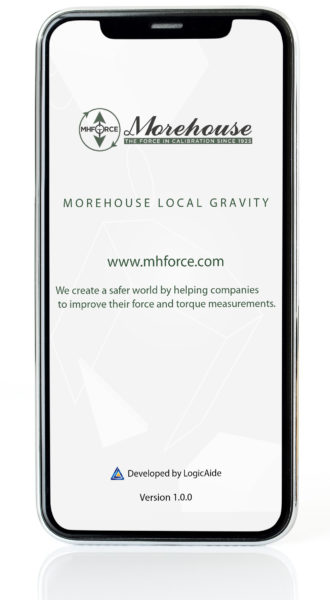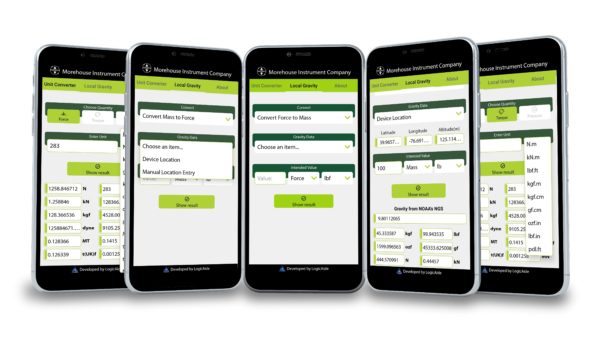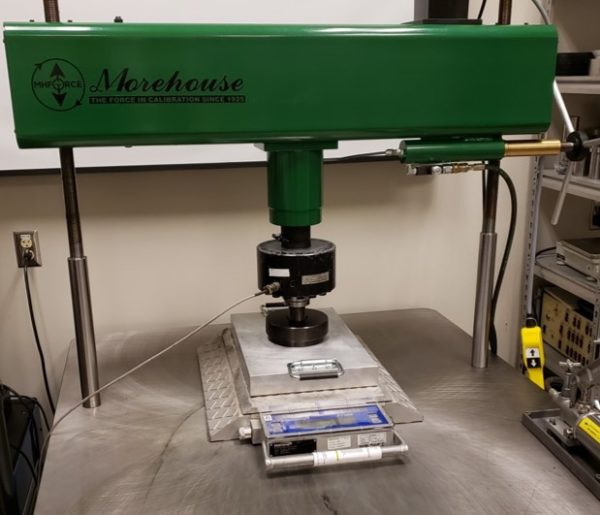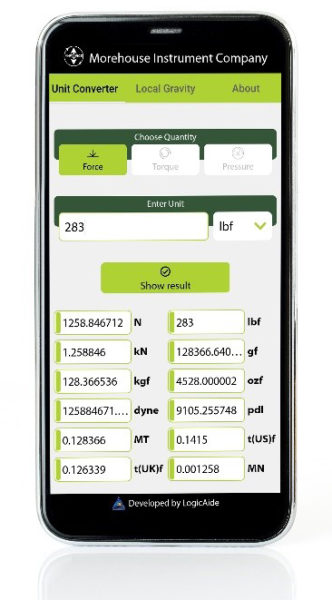Morehouse Has an App to Convert Force to Mass, Mass to Force and it uses NOAA so it should be known to be within 5 ppm!

When someone asks us about converting force to mass, Morehouse can now say we have an app for that. Not only will our app convert force to mass, but it will convert mass to force as well as convert units. It will convert force, torque, and pressure units. Anyone interested in downloading the app can visit the Google Play Store here or scan the QR code below at the end of this article.
Let’s look at why this app is needed.

Using Mass weights to calibrate a force-measuring instrument can result in large measurement errors.
When metrologists talk about measurement error, we’re talking about the difference between the nominal value and what the instrument is reading. If 10,000 lbf is applied to a force measuring device and the readout displays 10,002 lbf, then the device has a 2 lbf bias. If we load the same force measuring device to 10,002 lbf, we will have applied 10,000 lbf. This is a measurement error, and there can be many different causes. After speaking with several professionals in the weighing industry, it has come to my attention that some labs use mass weights to calibrate force devices. These include dynamometers, crane scales, hand-held force gauges, and others. This can result in significant measurement errors.
Let’s quickly review the difference between mass and force. Mass, under almost every terrestrial circumstance, is the measure of matter in an object. Measuring force takes additional factors into account: air density, material density, and gravity. It’s the effect of gravity that can produce significant errors when comparing mass and force measurements.
It is very important that the gravitational value for the Laboratory is established. The effect of not doing this could be a variation in the force produced by the weight of perhaps 0.1 % or more of the reading. It is therefore strongly recommended that you establish the local value of gravity (g) for your Laboratory and use weights that have been calibrated at that gravitational constant.
Gravity is not constant over the surface of the earth. The most extreme difference is 0.53 % between the poles and the equator (983.2 cm/s2 at the former compared to 978.0 cm/s2 at the latter). A force-measuring device calibrated in one location using mass weights and then deployed somewhere else will produce different strains on the physical element. The resulting measurement errors can be significant.
Correcting for the difference in force and mass measurements is possible. When a device is adjusted for force measurements, the device will measure force without additional error for gravity correction, air density correction, and so on needed.
The Morehouse app will use your exact coordinates, go to NOAA’s website, and convert the mass value to force using this formula.
Force = M x g / 9.80665 m/s2 (note: to properly convert mass-to-force material density and air density should be known) This formula will have additional errors that are likely less than 0.02 %. For more information on mass-to-force, please read this blog.

Pictured Above: Morehouse SCM-60 Aircraft and Truck Scale Calibrating Machine
Using force instruments to calibrate in mass has a similar measurement error.
Forces are defined by Newton’s second law of motion are expressed by F =kMA. Forces are not the same as or can they be substituted for mass without correction. Phillip Stein once wrote in his paper Gravity of the Situation, “Some measurements and calibrations require knowledge of little g. Errors and uncertainties in little g fall right to the bottom line (a 1% error in g results in a 1% error in the force reported) and therefore exert an important influence on the correctness of measurement results.”
A common example of these measurement errors occurs with scales (a mass measurement device). If 1000 lbs mass is used to calibrate a scale at Morehouse and that scale is shipped to Denver, CO, it would have to be calibrated again or corrected by formula to obtain the proper mass. Just comparing the gravity in York (9.801158 m/s2) and Denver (9.79620 m/s2), we find a difference of about 0.05 %. Without correction, 1000 lbs applied would read as 999.5 lbs. If the accuracy of the scale were 0.01 %, then the device would be at least five times greater than the accuracy specification.
Converting Force to Mass requires knowing the local gravity where the weighing takes place.
A mass correction factor can be calculated to convert force to mass when the transfer standard is used at a location where the gravity is known as follows:
Mass Correction Factor = (9.80665/g)
where:
g = gravity at place of weighing, m/s2 - The gravity value at the place of weighing can be obtained from NOAA or the Morehouse app will do the same thing.
To determine Mass when a weighing is performed at the known gravity value multiply the applied force by the Mass Correction Factor as follows:
Mass = Force x Mass Correction Factor
Note: This formula works well for force transfer standards. This formula is for true or apparent mass. Most calibration service providers provide certificates using conventional mass.
Dynamometers, crane scales, tension links, handheld force gauges, and other similar devices are not always “Legal for Trade Scales”. Mainly, they can be used as force measuring devices because their displayed value can be adjusted based on a known force. If a known mass is used on-site, there is insignificant gravitational measurement error. The device can be used as a low-accuracy mass comparator. Since many of these instruments are used for measuring loads of 1 ton through 300 tons, it’s impractical to have the mass weights necessary to calibrate on-site, and calibrating using force may be the only practical method to certify the device.
Therefore, the best solution is to have your load cells, proving rings, crane scales, etc., calibrated in force, and convert the force readings at the location the instrument if being used to mass. If this is not done, the end-user can live with the error, or they can have someone with large amounts of masses come on location and calibrate the weighing device on-site. It’s often a logistics matter and calibrating in force and converting to mass is simple enough. It’s been further simplified by downloading the free Morehouse local gravity app.

Unit Conversions
We at Morehouse decided to develop a unit converter for force, torque, and pressure. We used the lbf to N direct conversion formula and then derived several other common and some non-common as shown above. The app also converts torque and pressure units.

Get Morehouse Local Gravity here. Also available on iTunes, just search Morehouse local gravity
Use of the APP
Note: This app uses GPS and therefore may not work inside of large concrete buildings. It's just like when you are driving and go through a large tunnel or are in a large parking lot. The app allows the coordinates to be entered manually or you could just step outside if needed.
Additional Reading
Phillip Stein published a great article in Measure for Measure called “Gravity of the Situation”
NIST Handbook 44
If you enjoyed this article, check out our LinkedIn and YouTube channel for more helpful posts and videos.
Everything we do, we believe in changing how people think about force and torque calibration. Morehouse believes in thinking differently about force and torque calibration and equipment. We challenge the "just calibrate it" mentality by educating our customers on what matters, and what causes significant errors, and focus on reducing them.
Morehouse makes our products simple to use and user-friendly. And we happen to make great force equipment and provide unparalleled calibration services.
Wanna do business with a company that focuses on what matters most? Email us at info@mhforce.com.
#convert force to mass #convert mass to force


